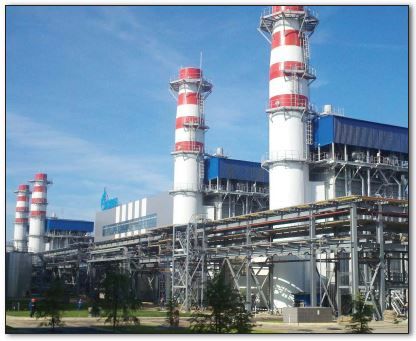Commissioning Russia's Adler Thermal Power Plant
In autumn 2009, Gazprom of Russia started the Adler Thermal Power Plant (Adler TPP) project in Sochi. Ansaldo Energia supplied the gas turbine generator sets. With an aggregate capacity of 360 MW, Adler TPP was designed to power 2014 international sports competitions.

Figure 1: The Adler power plant in Russia[/caption]
The power plant, comprising four gas turbines with related auxiliary systems, four heat recovery steam generators (HRSGs) and two steam turbines, delivered over onethird of expected peak demand in the Sochi area during the 2014 Winter Olympic Games. The heart of the plant is four AE64.3A GTs in a multi-shaft configuration, which can be fired either by gas or liquid fuel. The turbine control, monitoring and protection system is based on the Siemens SPPA T3000 platform.
The AE64.3A is the smallest GT manufactured by Ansaldo Energia. It is equipped with an annular combustion chamber fitted with 24 hybrid dual fuel burners which generate uniform temperature distribution in the combustion chamber and turbine stage. This makes it possible to keep NOx and CO emissions at a low level for a wide range of loads.
In order to reduce emissions, a premix combustion mode is used for both gas and distillate oil fuels. Air is spilled in the compressor section for turbine section cooling of both stationary vanes and rotating blades, making it possible to increase the firing temperature. The nominal GT speed is 5,413 rpm, so a gearbox is needed to reduce the speed and couple the GT with a generator running at a nominal speed of 3,000 rpm.
Adler project
There were several distinctive features of the Adler project. The control system is based on the “fully automatic” philosophy. This means that all sequences are run in automatic mode, once the operator has issued certain main commands (e.g., startup, shutdown, load target) or enabled certain functions (e.g., automatic synchronization).
The main tasks carried out automatically by the control system are GT startup, synchronization, loading, unloading, GT rundown and turning gear operation. This reduces operator actions to a minimum during normal operation, and the entire genset is said to operate smoothly and safely.
To keep the fuel oil nozzles clean and ready for liquid-fuel operation when required, an additional procedure has been implemented which uses compressed air to produce a temporary back-flow inside the nozzles. A drainage line was fitted with two pneumatic actuation valves to drain water and prevent condensation from accumulating in the pipes.
Periodically the control system checks the functional conditions during diesel operation, generates the command to open the pneumatic valves to allow drainage, and after a fixed period generates the command to close the pneumatic valves.
In the standard configuration for an AE64.3A, the power supply for auxiliary equipment (low voltage) is fed from a single source, considered as the main power supply. In Adler, in order to comply with more stringent redundancy requirements, the power supply is provided by two different sources. For this purpose, the system had to be capable of detecting fast switchover conditions on the low-voltage switchboard, and then carry out the switch in such a way as to avoid possible malfunctions or the risk of an emergency shutdown.
In addition, in order to further increase the reliability of the system, for each redundant component (e.g., lube oil main and auxiliary pump, hydraulic oil main and auxiliary pump) the power supplies were cross-connected between the units, i.e., the power supply for the main component was taken from its own low voltage switchboard, while the power supply for the redundant component was taken from another GTG unit. This ensures that in the event of a trip on one LV switchboard, either the main component or the auxiliary component continues to receive power and keeps on running.
For the lube oil system only, the GT is equipped with an emergency pump fed by 220 DC. The emergency pump receives a start command if either the main or auxiliary pumps are out of service.
A key feature of the Adler power plant control system is its ability to support the grid in the event of frequency changes due to load generation and distribution unbalancing. The term “frequency support” covers every modification needed to realize a system that can correct speed and load in such a way as to move the grid frequency as close as possible to 50 Hz. In the Adler Power Plant, this feature is implemented by the gas turbines. The steam turbines do not participate in frequency control activities.
The GT control system reads the frequency error (the difference between nominal speed and current speed) and if the error is greater than a preset dead band the load reference is changed according to the primary frequency droop requested. The purpose of frequency support is to allow the power plant to be able to change the load by up to 10% following a frequency change.